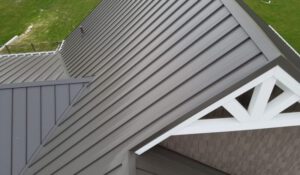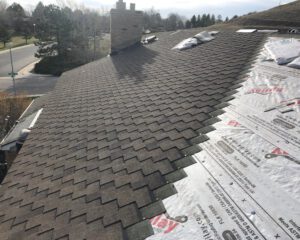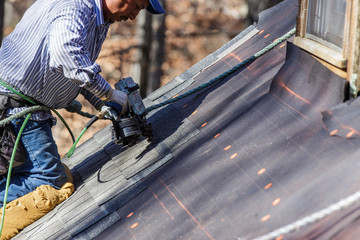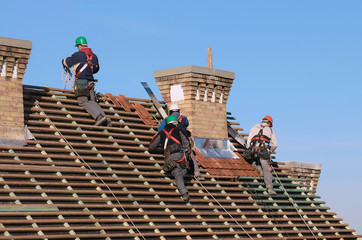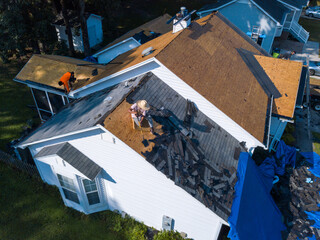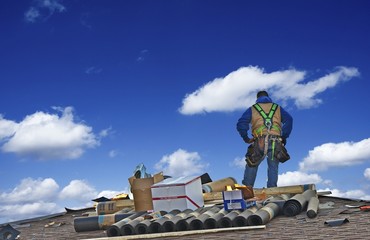
Many homeowners forget about their roof until it needs major repair. Maintenance is crucial to keeping your home safe and looking great. Aim for biannual inspections and preventative maintenance to catch any problems before they cause major damage.
For example, moss growth on the surface of a roof can be unsightly and cause water damage. Trimming trees and removing limbs over the house can also help protect the roof from squirrels and other critters looking for entry points into the home.
Check the Soffit and Fascia
Soffits and fascia are an important part of roof construction, but they’re often neglected unless something goes wrong with the roof. This is a shame, as these boards are designed to protect the home from water damage, and they can be quite beautiful, too. A well-maintained soffit and fascia board can add to the overall beauty of your house, so it’s worth taking the time to inspect them regularly.
Once a homeowner notices that the fascia or soffit is deteriorating, it’s important to act quickly to get them repaired. This will help prevent the moisture buildup that can cause rot and other issues, and it will also help ensure that the gutters and downspouts can do their job properly.
The soffit is a structure that sits beneath the roof eaves and provides ventilation for the attic space. It can be made from wood, aluminum or PVC. It’s important to keep in mind that the soffit can be easily damaged by pests, so it’s a good idea to check for insect or rodent nests every now and then.
When a homeowner neglects to check the soffit for pests, it can lead to water damage and other issues. This can include mold growth, which can affect the health of a family. It’s also a good idea to periodically clean the soffit, especially in areas that tend to collect dirt and dust.
A soffit is an essential part of the roof, and it can be found in most homes. It is a piece of lumber that’s installed underneath the shingles and connects to the edge of the roof. It is important to look for rotting or other signs of deterioration, and it’s also a good idea to have the soffit and fascia checked for leaks. If they’re leaking, it’s best to have the repairs done by a professional to avoid further problems.
Check the Flashing
If your roof has chimneys, vent pipes, skylights, or dormers, the flashing is a key element that helps prevent water damage. It is a thin sheet of metal that wraps around these features to direct water away from the areas where shingles are vulnerable. The flashing is made from copper, steel, or aluminum, but it should always be sealed with a good-quality caulking.
When a leak occurs near these areas, it can cause serious damage that extends well beyond the roof. It can affect the structure of your home, causing rot in walls and ceilings and even weakening beams. In addition, it can cause mold and mildew to grow in the attic and other rooms of your home. If you have a leaky roof, it is critical to have the flashing repaired immediately to avoid extensive water damage.
The most common signs of flashing damage are water stains in your attic or on the ceilings of rooms in your home, a visible gap between the roofing and the wall, or cracks in the flashing. You should also look for any dents or bends in the flashing, as well as signs of corrosion or rust on the metal.
A professional should always inspect the flashing, as it is difficult to repair yourself. Since the flashing is usually installed under a layer of shingles, it can be difficult to get access to. A professional can inspect the flashing and make any necessary repairs before a leak causes major problems in your home.
Another thing that a roofer should check is the condition of the flashing around chimneys, vents, dormers, and other features on your roof. The flashing is usually made of two different pieces, step and counter flashing. The step flashing is an L-shaped piece of metal that is placed under the shingles and along the chimney, while the counter flashing is set into a groove that is cut into the chimney bricks. The counter flashing is then caulked to the step flashing to create a seal. The counter flashing should be checked for rust and corrosion, as well as any gaps or holes that need to be repaired.
Trim Tree Branches
Trees are lovely additions to any yard, but they must be regularly trimmed or they can cause damage to your roof. Branches that hang over your house can scrape the siding, retain moisture and promote mold growth, and allow pests and animals to invade the interior of your home. Tree limbs that are too close to your roof can also damage the structure of the roof itself, leading to leaks. In some cases, trees need to be removed completely if they are unstable or dead.
You should hire a professional to trim the branches and limbs around your house. In some cases, a residential tree trimming company can perform this service, but in others, you may need to hire a landscaper or gardener who is experienced with working on and trimming trees. In unique circumstances, an arborist may need to be consulted as well.
Whenever you are pruning tree limbs, it is important to make the cut on the outside of what is called the branch collar. This is the swollen area that sticks out from the trunk and has rougher bark. If you cut inside the collar, it will not heal properly and can lead to rot later on. Instead, you need to find a spot on the underside of the limb that is several inches out from the collar, and cut into it there. Then, move up to the top of the limb and cut several inches farther out again, until it breaks off on its own.
Before cutting any limbs, you should always check with local city bylaws and your arborist to ensure that it is okay to do so. In some areas, certain types of trees are protected and cannot be trimmed, while in others, it is illegal to remove any limb that is within a specific radius of power lines. In any event, a professional will be able to help you safely and effectively prune your trees and keep them clear of your roof.
Inspect the Gutters
Gutter systems are designed to channel water away from the roof. They can also protect siding, foundations and other areas of a home from water damage. But they can only do this if they’re free of debris and functioning properly. And that’s why it’s important to inspect gutters regularly, especially following a severe storm.
Whether you’re a homeowner or a commercial property owner, it’s essential to have your building’s gutter system inspected for damage and in need of repairs on a regular basis. The best time to do this is during the spring, just after a harsh winter but before the summer rains start.
In addition to checking for the common problems like clogs and sagging, it’s important to pay special attention to the downspouts. Downspouts can get clogged by leaves, moss or even animals’ nests. If this is the case, they may be unable to properly channel water and may need to be cleaned or replaced.
Downspouts should be placed so that they are at least 4 to 6 feet away from a house’s foundation. This helps to prevent oversaturation of soil around the foundation and minimizes moisture problems in basements and crawl spaces. Additionally, it’s important to check for any leaks in the gutters themselves or a downspout that’s leaking at the seams of two sections.
When performing an inspection of the gutters, make sure you’re not too high up and are using a ladder that isn’t leaning on any gutters or other parts of your building. It’s also a good idea to bring binoculars for better visibility as well as a ladder leveler to ensure the most accurate assessment of your gutters’ condition.
These inspections are the most effective for identifying potential problems before they cause major structural damage or rot to your home or building. By adding these roof and gutter inspections to your maintenance program, you can be sure your roofing and gutter system are functioning the way they should and protecting your investment. In addition, you can also feel confident that any issues found are addressed promptly and professionally.




